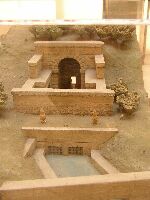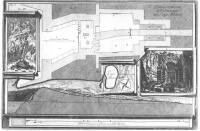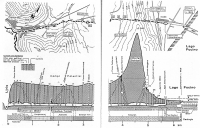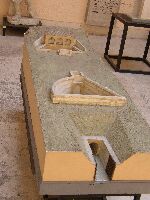



Model at the Museo della Civilta Romana in Rome-EUR.
From: M. Döring (1995): Der Emissar des Sees von Fucino / Italien (in: SdFG vol 19)
Model at the Museo della Civilta Romana in Rome-EUR.
Emissaries
An emissary is an open or subterranean natural or artificial channel by which an outlet is formed to carry off any stagnant water. The most remarkable works carry off the waters of lakes surrounded by hills like at volcanic craters.In ancient Greece, the most remarkable example was the subterranean channels that carry off the waters of Lake Kopais into the Cephisus, which were partly natural and partly artificial. About 480 BC Phaeax built an emissary at Agrigentum in Sicily to drain the city. Both channels were admired for their sheer size, although the workmanship was crude.
The ancient Etruscans and Romans excelled in the construction of emissaries, as in all their hydraulic works, and remains are extant showing that the lakes Ariccia, Albano, Nemi, and Lake Fucino were drained by means of emissaries.
The Ariccia canal was constructed before the Nemi tunnel. The water exiting the latter flowed through a canal which then crossed the Ariccia crater. At its deepest point the canal went subterranean and it was this underground tunnel that drained the water from the Ariccia crater. The emissary of Lake Nemi was about 1600m long and constructed in counter excavation mode in the 6th or 5th c bc. It had a rectangular section with an average gradient of 0,8%
Around 400 bc the Albanus Lacus (Lake Albano) was drained by a tunnel of over 1400m length built by Etruscans / Romans. Its rectangular cross-section was 1m wide and 3m high with an average gradient of 0,12%. There were only two vertical shafts with might have caused severe problems in terms of orientation.
Fucine lake
"About the same time, the mountain between Lake Fucinus and the river Liris was bored through, and that this grand work might be seen by a multitude of visitors, preparations were made for a naval battle on the lake [ ... ] When the sight was over, the outlet of the water was opened. The careless execution of the work was apparent, the tunnel not having been bored down so low as the bottom, or middle of the lake.
Consequently after an interval the excavations were deepened, and to attract a crowd once more, a show of gladiators was exhibited, with floating pontoons for an infantry engagement. A banquet too was prepared close to the outflow of the lake, and it was the means of greatly alarming the whole company, for the water, in the violence of its outburst, swept away the adjoining parts, shook the more remote, and spread terror with the tremendous crash."
(parts from Tacitus Annals XII, 56-7, translation from www.mit.edu)
So Claudius inaugurated what was to have been a complete drainage scheme, but the water level dropped by just 4 meters and stabilized, leaving the lake very much there. This while Suetonius reported an 11 years construction period and a work force of about 30.000 men. Hadrian tried it again, but failed. It was not until 1878 that Lake Fucino was finally drained. The modern version has the same course as the Roman one, which was almost completely destroyed in the construction of the modern one.
Julius Caesar is said to have first conceived the idea of draining Lake Fucino (Suet. Jul. 44). Originally the lake had a surface of about 140 m2 which was reduced in Claudius time to 90 km2. After the additional reconstruction work of Hadrian the lake shrank to about 57 km2. Between 1854 and 1876 the lake was completely drained by means of the Torlonia tunnel which carried the water of the Fucino basin to the Liri river.
Lake Fucine, located 100 km east of Rome, had no outlet. The lake experienced dramatic changes in water level, which caused serious problems to the people living in this fertile area. The total length of the emissary was about 6.000m, it had a cross-section of 5m2, was equipped with 33 vertical shafts, and an average gradient of 0,15% with an estimated capacity to drain 10 m3/s, five times smaller than required to control the level of the lake.
Mainly based on: Castellani and Dragoni (1991): Italian Tunnels in Antiquity